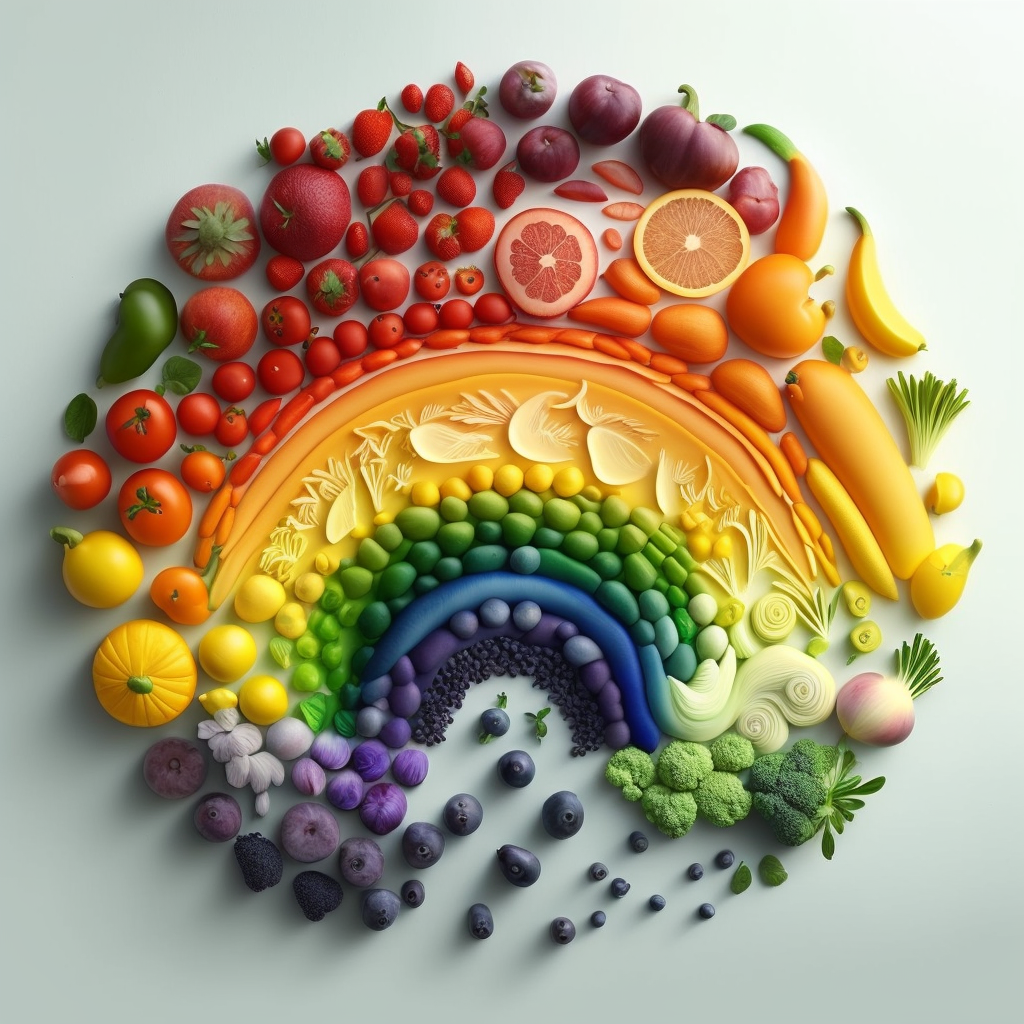I’ll admit it. When I first started putting knife to cutting board, I knew nothing.
Thought I did.
I just knew what I wanted and what tasted good to me. I clung to my ignorance, I hated on “fine dining”. It all sounded like, “french word, french word, french word chicken”.
At times it still sounds that way, frankly. But, I learned that I can never stop learning. In life and especially in the culinary world. So, in my continued efforts to become a better chef I wanted to bring you along for the ride.
I put together this list of basic culinary terms to get you going and help decipher some things thrown around in recipes and cooking shows.
This will be an ever growing list so please feel free to add to it in the comments. Also be sure to bookmark the page for later reference.
AL DENTE: Slightly undercooked, to a chewy consistency, from the Italian phrase “to the tooth.” Usually refers to the cooking of pasta but also applies to vegetables that are blanched, left still slightly crisp.
ASPIC: A jelly made from clarified meat, poultry, fish or vegetable stock.
AU JUS: Roasted beef, lamb, or poultry served with natural pan juices that accumulate during their cooking.
BAIN-MARIE: A hot water bath, used to keep food warm on top of the stove. It’s purpose is to keep sauces and such from separating. Also a hot water bath used when cooking custards or eggs in the oven to keep them from curdling, cracking or browning.
BARBECUE: To cook meats, poultry, or vegetables over woods, charcoal, or gas on a grill, in open pits or on a spit over high heat. Sometimes marinating first and basting during the cooking time. *unless you’re from California.
BASTE: To keep foods moist during cooking by brushing, drizzling or spooning on a sauce, pan juices, or wine.
BEAT: To mix ingredients quickly so that air is incorporated, creating a smooth creamy mixture.
BEURRE MANIE: Equal amounts of softened butter and flour mixed together and then added in small amounts as a thickening agent to hot sauces or soups. *oooh fancy
BIND: To add an ingredient such as eggs, which hold together the other ingredients, as in meatloaf.
BLANCH or BLANCHE: To plunge vegetables, fruit, or seafood into boiling water for a very brief amount of time to bring out the color or to loosen skins for peeling.It is best to blanch vegetables and then refresh under cold, running water.
BLEND: To combine ingredients together to a certain consistency. Sometimes until smooth, other times until just mixed together (such as with biscuits).
BLIND BAKE: To bake a pastry before it is filled to create a crisper crust and to prevent puffing during baking. The pastry is poked with a fork along the sides and bottom and then lined with foil and filled with pie weights, dry beans or uncooked rice. (the beans or rice may be used a few times before discarding, after a few uses they loose all moisture which results in less weight) The foil and weights are removed shortly before the end of the baking time, returned to the oven for a few more minutes, thus allowing for the pastry to brown lightly before using.

BONE: To remove the bones from meat, poultry, or fish, using a thin boning knife.
BOUQUET GARNI: A small bundle of herbs, usually leaves, parsley, and thyme, wrapped with cheesecloth and added to soup or stew for flavor.Once dish is cooked, the Bouquet Garni is removed and discarded.
BRAISE: To brown meat in fat over high heat, then cover and cook slowly in the oven in a small amount of liquid.Ideal method of cooking tougher cuts of meat.
BREAD: To coat with bread crumbs.
BROIL: To cook with intense direct heat either on a grill or under an oven’s broiler.The high heat seals in the juices, browns the outside, keeping the food tender.
BROWN: To cook food quickly in a preheated oven, broiler, or hot skillet to “brown” the outside and seal in the juices.
BUTTERFLY: To horizontally split open a food such as shrimp, chicken breast, pork chops, or boneless leg of lamb, cutting almost but not quite all the way through, like an open book. Butterflying opens the item so that it may be filled or to expose more surface area so the item cooks more evenly.
CANDY: To cook and coat ingredients in sugar or simple syrup
CARAMELIZE: To dissolve sugar and water slowly, then boil until it turns caramel brown.Or to cook meat or vegetables and bring out their natural sugars such as with caramelized onions.
CHIFFONADE: Very finely shredded or sliced leafy vegetables or herbs, such as spinach or basil leaves. This is achieved by stacking the leaves, rolling the leaves lengthwise into a tight tube and then thinly slicing. “Chiffon” is French for “little rag” referring to the fabric-like strips that result from this technique.
CLARIFY: To clear stock by straining through cooked egg whites; or to make butter clear by melting, then separating , and discarding the white milk solids from the yellow butter.
CODDLE: To poach in slowly simmering water.
COMBINE: To mix two or more ingredients together.
CORE: To remove the center or core of various fruits and vegetables, such as apples, pears, pineapple, lettuce or cabbage.
COURT BOUILLON: A broth made of water, wine, herbs and spices used for poaching fish or as a base for fish soups.
CREAM: To mix a softened ingredient, such as butter, alone or with other ingredients, such as sugar, until well blended and smooth.
CREME FRAICHE: A dairy product that is similar in taste to sour cream but a bit more tart.Used as a dessert topping or in soups.To make at home – Mix together 1 cup whipping cream and 1 tablespoon white vinegar in jar, cover, and let stand on the counter for 24 hours.Shake and refrigerate. *all I can think about is that Southpark episode now…
CRIMP: To decorate the edge of a pie crust by pinching dough together with fingers.
CUBE: To cut food into cube-shaped pieces, usually ranging in size from 14-inch to 1 inch.
CURDLE: The separation that occurs in egg or cream-based mixtures when they are heated to quickly.
CURE: To preserve meats by either smoking, drying, salting, or pickling.
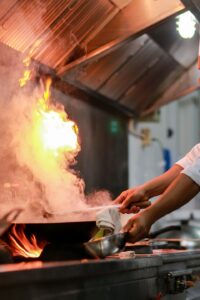
CUT IN: To combine butter or shortening with dry ingredients until the mixture resembles coarse meal by using a pastry blended, to dinner knives,fingers, or a food processor.
DASH: A small quantity. *aka 1/5 tsp…and who tf has a 1/5th teaspoon???
DEGLAZE: To add a liquid, such as wine, water or broth to a pan in which food, usually meat or poultry, has been cooked, stirring and scraping up the browned bits from the bottom of the pan.The liquid is then reduced to the desired consistency and drizzled on the food for a more intense flavor.
DEGREASE: To skim the layer of fat from the top of a soup, sauce, or stock.Easier to do if the liquid is first chilled.This solidifies the fat, which will them remove very easily.
DEVEIN: To remove the dark intestinal vein from a shrimp by using a sharp knife to slightly cut through the back and then the tip of the knife to remove the vein itself.
DICE: To cut into equal-sized small cubes about 14-inch.
DISSOLVE: To cause a dry substance become incorporated into a liquid so as to form a solution.
DOT: To scatter small pieces of butter over the top layer of a prepared dish.
DREDGE: To lightly coat food, usually with flour or bread crumbs.Or to fill a paper bag with seasoned flour and shake the ingredient to be cooked in the bag.Be sure to always shake off any excess flour before browning or frying.
DRIPPINGS: The juices, fat and brown bits that are left in a pan after meat or poultry has been roasted or sautéed.After skimming of the fat, the dripping are often used for sauces or gravies.
DRIZZLE: To slowly pour a very thin stream of liquid lightly over food. *Why does Snoop Dogg carry an umbrella? Fa drizzle! (I’m so sorry)
DUST: To sprinkle very lightly with flour or sugar.
EMULSIFY: To bind liquids that usually do not blend together smoothly, such as oil and water or vinegar. This is achieved by adding the oil in a slow and steady stream to the water or vinegar while whisking vigorously. Mustard and egg yolks are natural emulsifiers, and help bind such liquids in sauces and vinaigrettes.
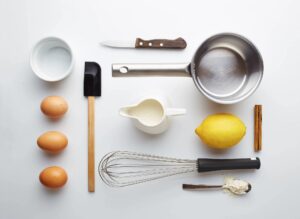
FERMENT: To bring about a natural chemical change in food or beverages. Such items as beer, wine, vinegar, cheese and yeast bread all get their distinctive flavors from fermentation.
FILLET: To cut meat, chicken, or fish from the bones.
FLAMBÉ: To pour liqueur over food, warm it, and ignite with a match, burning off the alcohol.
FOLD: To incorporate one ingredient into another without stirring or beating but instead by gently lifting from underneath with a rubber spatula, while turning the bowl.
FRY: To cook food in hot fat in a skillet over high heat until brown and crisp.
GARNISH: To decorate food with fresh herbs, edible flowers, fresh vegetables, or fruit to enhance the look and taste of the dish.
GLAZE: To apply a coating of a glossy, often sweet, sometimes savory, substance applied to food typically by dipping, dripping, or with a brush.
GRATE: To change a solid food, such as cheese, into fine shreds by rubbing it against a hand grater or through the grating blade of a food processor.
GRATIN: Food, mostly vegetables, topped with grated cheese or bread crumbs, drizzled or dotted with butter or oil and baked in a shallow “gratin” dish, and baked or browned under a broiler.
GREASE: To lightly coat a pan with some fat to prevent foods from sticking and to help with the browning.
GRILL: To cook on a rack over very hot coals or under a broiler in order to seal in juices.
GRIND: To use a mortar and pestle, a food processor, a pepper grinder, or a meat grinder to transform a solid piece of food into fine pieces.
HORS D’OEUVRE: A bite-size savory appetizer, either cold or hot, served with cocktails or before dinner.
HULL: To pluck out the green stem and leaves of berries, usually strawberries.
JULIENNE: To cut fresh vegetables or other foods into thin matchstick-size strips of uniform length
KNEAD: To work dough, after blending ingredients, with the palms of your hand on a lightly floured surface, making it smooth and elastic.
LEAVEN: To cause a mixture to rise while it is baking by adding baking powder, baking soda, or yeast.
LINE: To cover the surface of a baking sheet or roasting pan with foil, waxed, or parchment paper to prevent sticking.
LUKEWARM: At a temperature of about 95 degrees Fahrenheit. Neither hot nor cold. Think of baby bottle temperature and you’ve achieved lukewarm.
MACERATE: To cover fruits or vegetables with a liquid, often a liqueur or lemon juices and sugar,and let them rest until the flavor has been absorbed and the fruits or vegetables softened.
MARINATE: To tenderize and flavor food by placing it in a seasoned liquid, usually composed of some combination of vinegar, lemon juice, wine, oil, herbs, and/or spices.
MERINGUE: Egg whites beaten stiffly with sugar and then baked in a low oven.
MICROPLANE: A grater used for the grating of various food items and used to zest citrus.
MINCE: To cut or chop into very fine pieces.
MIX: To stir ingredients together with a spoon or fork.
MUDDLE: To combine ingredients by pressing them with a muddler before adding the majority of the liquid ingredients.
MUDDLER: A long pestle shaped bar tool that is commonly made of wood, but can be found in stainless steel or plastic with teeth on the bottom. The wooden variety works well with more delicate herbs such as mint in a mojito. While the variety with teeth really work well for this drink and others that have fruits to be crushed.
PAN-BROIL: To cook on top of the stove in a preheated heavy skillet over high heat, pouring off any fat or liquid as it accumulates.
PAR BOIL: To partially cook in boiling water or broth.
PARE: To use a thin knife to remove skin or rind from vegetables and fruits.
PEEL: To strip off an outer layer from vegetables and fruits.
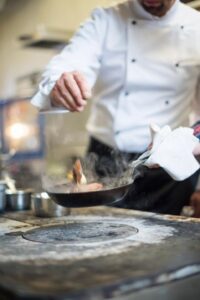
PHYLLO: A Tissue-thin sheet of dough.
PICKLE: To flavor and preserve meats, vegetables and fruits in brine.
PINCH: The amount of dry ingredients you can bold between your thumb and finger.
PIPE: To decorate food with a stiff smooth mixture, such as frosting, by forcing it through a pastry bag.
PIT: To remove the pits from stone fruits or olives.
PLUMP: To soak dried fruits in liquid until they swell and are rehydrated.
POACH: To cook food gently in simmering liquid that does not boil.
POUND: To flatten or tenderize meat with a heavy mallet or pan, often between to sheets of waxed paper.
PREHEAT: To set an oven, grill, or broiler at the desired temperature about 15 minutes before use so that the desired temperature is reached before the food is put in to cook.
PRICK: To pierce pastry or food with the tines of a fork or a knife to prevent it from bursting or rising during baking.
PROOF: To test yeast to be sure it is alive and active. Dissolve the yeast in warm liquid with a little sugar or honey.Let stand for 5 to 10 minutes.If the yeast is alive it will foam and bubble up.
PUFF PASTRY: Light, flaky pastry of many thin layers of flour, butter, water and salt.The layers are made by repeatedly rolling and folding the dough, causing it to “puff up” when baked.
PUREE: To mash solid food or to pass it through a food mill or in a food processor until it is smooth.
RECONSTITUTE: To rehydrate dry food by soaking in a warm liquid.
REDUCE: To thicken or concentrate a sauce by boiling down, which lessens the amount but intensifies the flavor without any added fat.
REFRESH: To run hot food under cold water or to plunge into cold water to stop the cooking and retain the color.
RENDER: To liquefy a solid fat over low heat.
RICE: To push a soft cooked food, such as potatoes, through a food mill, mesh strainer or a potato ricer.
ROAST: To cook by the free circulation of dry heat, often beginning with a very hot oven to seal in juices and then reducing the heat to complete the cooking.
ROUX: A mixture of melted butter or oil and flour cooked over low heat, and stirred constantly,to make a base for thickening a sauce.
SAUTÉ: To cook food in butter or fat in a skillet until lightly browned.Sautéing is usually a quick process so any meats being sautéed should be tender cuts.
SCALD: To cook a liquid, most often milk, over low heat until just before it boils.
SCALLOP: To bake a food, usually in a casserole, with liquid. Crumbs are often sprinkled on top at the end of the baking time, such as with scalloped potatoes.
SCORE: To make very thin slashes along the surface of fish or meat to help tenderize it and keep it from curling up when cooked.
SEAR: To brown the surface of meat very quickly in a hot oven, under a broiler, or in a pan over high heat on top of the stove to seal in juices.
SHRED: To tear or cut into long thin pieces.
SHUCK: To remove the shells from oysters, mussels or clams. Also to remove the husks and silk from corn.
SIFT: To pass dry ingredients through a fine-mesh strainer to remove lumps and lighten the texture. Dry ingredients that are free of dry lumps may also be whisked together to achieve the same result.
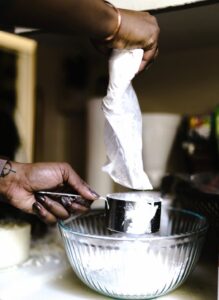
SIMMER: To cook liquid alone or with other ingredients over low heat, not boiling.
SIMPLE SYRUP: A boiled mixture of water and sugar. There are several thicknesses of simple syrup and they have different uses. Thin simple syrup -3 parts water to 1 part sugar, is used to glaze cakes and cookies. Medium simple syrup – 2 parts water to 1 part sugar, is used to sweeten iced tea and make lemonade. Thick simple syrup – 1 part water to 1 part sugar, is used to glaze candied fruits and is the basis of cocktails.
SKEWER: A long thin metal or wooden stick used to secure or suspend meat and vegetables during cooking. Smaller skewers are used for serving appetizers. Wooden skewers should be soaked in water for at least 20 minutes before skewering food and placing on a hot grill or under the broiler.
SKIM: To remove fat or scum that rises to the surface of a cooked liquid with a spoon.
SLIVER: To cut food into long thin strips.
SOUFFLÉ: A baked food, either a dessert or entrée, made light and fluffy with the addition of beaten egg whites before cooking. The food will puff or rise up but generally falls fairly quickly after removing from the oven.
STEAM: To cook food, covered, over a small amount of boiling water.
STEEP: To extract color, flavor, or other qualities from a solid substance by leaving in liquid that is just below the boiling point for a specific amount of time.
STEW: To slowly cook meats and vegetables in liquid in a covered pan, either in the oven or on top of the stove.
STIR-FRY: To quickly sauté meat or vegetables while stirring constantly in a very hot wok or skillet.
STOCK: A long-simmering broth made from meat, poultry, fish bones and/or vegetables with the addition of herbs and spices. *Common mistake: Stock has to come from bones or something with bones. Hence, veggie stock isn’t really a thing…but I’ll let you live.
STRAIN: To remove solids from liquids by pouring through a colander or sieve.
TEMPER: To heat food gently and slowly before adding a large amount of hot mixture. This prevents the mixture from separating or curdling.
TOAST: To brown by baking or to brown by placing food under direct heat.
TRUSS: To tie the legs and wings of poultry close to the body with string before roasting.
VINAIGRETTE: A classic dressing made from a mixture of vinegar, oil, salt and pepper.Other flavorings such as garlic, shallots, mustard, etc. can be added as well.
WHIP: To beat rapidly, either by hand or with an electric mixer to add air and increase volume.
ZEST: To remove in fine strips the outermost colored peel or “zest”, of citrus fruits, being careful not to cut into the bitter white pith that lies just below the peel
